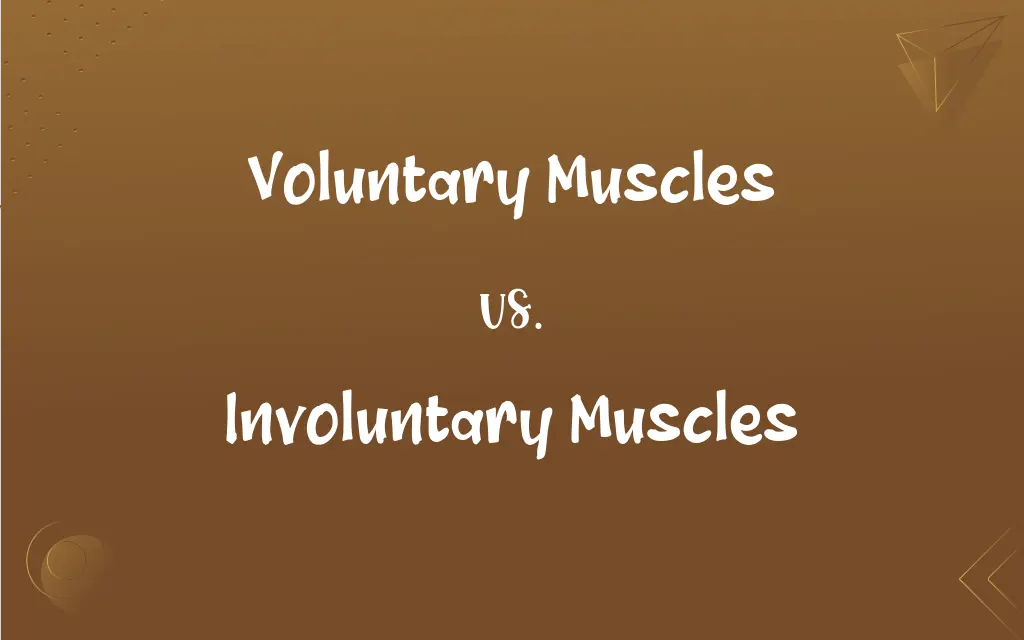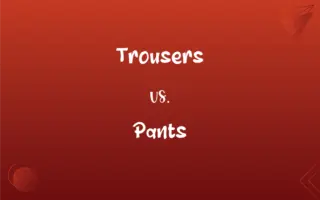Voluntary Muscles vs. Involuntary Muscles: What's the Difference?
Edited by Janet White || By Harlon Moss || Updated on October 27, 2023
Voluntary muscles are controlled consciously, allowing movement; involuntary muscles operate automatically, managing internal functions.

Key Differences
Voluntary muscles, as their name suggests, are the muscles that we can control consciously. These muscles play a pivotal role in our body's movement, enabling us to walk, jump, and grab. Involuntary muscles, on the other hand, function without our conscious control and are responsible for essential bodily processes, like the heartbeat and digestion.
The structure of voluntary muscles is quite distinct. These muscles, often referred to as skeletal muscles, attach to bones via tendons and allow our skeleton to move. Involuntary muscles, however, are primarily of two types: smooth muscles, which are found in organs like the stomach and intestines, and cardiac muscles, present in the heart.
When considering fatigue and endurance, voluntary muscles can get tired after continuous use, requiring rest for recovery. In contrast, involuntary muscles, especially cardiac muscles, have a high endurance level and work relentlessly throughout our lives without needing a conscious rest.
Another crucial distinction lies in the appearance and structure of these muscles. Voluntary muscles have a striated or striped appearance under the microscope. Involuntary muscles, particularly the smooth muscles, lack these striations and have a more uniform appearance. Cardiac muscles, being involuntary, have a unique structure with striations but differ from skeletal muscles in function and location.
Overall, both voluntary muscles and involuntary muscles are fundamental to our survival. While voluntary muscles let us interact with our environment, involuntary muscles ensure our internal systems function seamlessly, without us having to think about them.
Comparison Chart
Control
Conscious
Automatic
Main Types
Skeletal
Smooth (organs) and Cardiac (heart)
Fatigue Level
Can fatigue with use
High endurance, especially cardiac
Appearance
Striated
Smooth muscles are non-striated; cardiac are striated
Primary Function
Movement of the skeleton
Manage internal bodily functions
Voluntary Muscles and Involuntary Muscles Definitions
Voluntary Muscles
Muscles consciously controlled for movement.
She flexed her voluntary muscles to lift the weight.
Involuntary Muscles
Crucial for sustaining internal body processes.
Thanks to involuntary muscles, our digestive system operates without thought.
Voluntary Muscles
Prone to fatigue with continued use.
After the marathon, his voluntary muscles were sore and tired.
Involuntary Muscles
Cardiac muscles have high endurance, working non-stop.
Unlike other muscles, the involuntary muscles in the heart never tire.
Voluntary Muscles
Essential for physical interactions with the environment.
He used his voluntary muscles to jump and catch the ball.
Involuntary Muscles
Comprise smooth and cardiac muscle types.
The stomach's involuntary muscles help in digestion.
Voluntary Muscles
Also termed skeletal muscles, attached to bones.
The biceps and triceps are examples of voluntary muscles.
Involuntary Muscles
Operate automatically without conscious control.
The heart's involuntary muscles pump blood consistently.
Voluntary Muscles
Exhibit striated appearance under a microscope.
In biology class, they studied the striated structure of voluntary muscles.
Involuntary Muscles
Smooth muscles are non-striated; cardiac muscles are.
Under the microscope, the smooth type of involuntary muscles lacks stripes.
FAQs
Do voluntary muscles allow us to walk and jump?
Yes, voluntary muscles enable conscious movements like walking and jumping.
Are biceps considered voluntary muscles?
Yes, biceps are examples of voluntary or skeletal muscles.
Which involuntary muscles aid digestion?
The smooth muscles, a type of involuntary muscle, assist in digestion.
Can voluntary muscles become fatigued?
Yes, with continuous use, voluntary muscles can tire and need rest.
Can training improve voluntary muscle performance?
Yes, training and exercise can enhance the strength and endurance of voluntary muscles.
Are all voluntary muscles striated?
Yes, voluntary or skeletal muscles have a striated appearance.
Can involuntary muscles regenerate after injury?
Cardiac muscles have limited regenerative capacity, while some smooth muscles can regenerate.
Is the heart the only organ with involuntary muscles?
No, besides the heart's cardiac muscles, organs like the stomach have smooth involuntary muscles.
Do involuntary muscles respond to external stimuli?
Involuntary muscles can react to internal and external factors, but not consciously controlled stimuli.
Can diseases affect involuntary muscle function?
Yes, conditions like cardiomyopathy can impact involuntary cardiac muscle function.
Do involuntary muscles ever rest?
While some involuntary muscles can relax, cardiac muscles work non-stop without resting.
Are leg muscles considered voluntary?
Yes, the muscles in our legs are voluntary, allowing us to move consciously.
Which muscles control our heartbeat?
The involuntary muscles, specifically the cardiac muscles, regulate the heartbeat.
Do involuntary muscles exhibit stripes under a microscope?
Only cardiac muscles, a type of involuntary muscle, have striations. Smooth muscles do not.
Which muscles are responsible for reflex actions?
While initiated by the nervous system, reflex actions involve rapid contraction of voluntary muscles.
Are tendons associated with voluntary muscles?
Yes, tendons connect voluntary skeletal muscles to bones, enabling movement.
Can we consciously control involuntary muscles?
No, involuntary muscles operate without our conscious intervention.
Which muscles ensure our lungs expand for breathing?
The diaphragm, a voluntary muscle, and intercostal muscles aid in breathing.
Are all muscles in the arms voluntary?
Primarily, arm muscles are voluntary, enabling us to move our arms consciously.
Are facial expressions controlled by voluntary muscles?
Yes, facial expressions result from the contraction of voluntary facial muscles.
About Author
Written by
Harlon MossHarlon is a seasoned quality moderator and accomplished content writer for Difference Wiki. An alumnus of the prestigious University of California, he earned his degree in Computer Science. Leveraging his academic background, Harlon brings a meticulous and informed perspective to his work, ensuring content accuracy and excellence.
Edited by
Janet WhiteJanet White has been an esteemed writer and blogger for Difference Wiki. Holding a Master's degree in Science and Medical Journalism from the prestigious Boston University, she has consistently demonstrated her expertise and passion for her field. When she's not immersed in her work, Janet relishes her time exercising, delving into a good book, and cherishing moments with friends and family.
































































